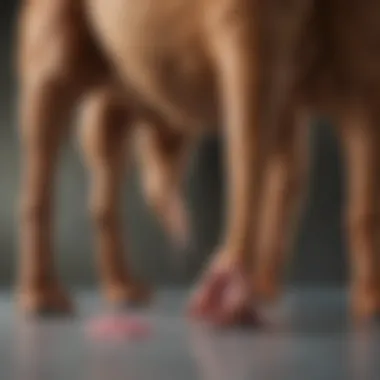Understanding Why Dogs Drag Their Bottoms


Intro
Scooting, commonly observed in dogs, can be a perplexing behavior for pet owners. This article aims to delve into the underlying causes of why dogs drag their bottoms across surfaces. Various factors contribute to this behavior, ranging from medical issues to behavioral tendencies. Understanding these reasons is vital for ensuring the health and well-being of our canine companions.
Animal Overview
Common Name and Scientific Classification
The common dog, known scientifically as Canis lupus familiaris, has been domesticated for thousands of years. This species exhibits a wide range of sizes and breeds, each with unique characteristics. The sheltered environment of homes has led to diverse adaptations among different breeds, influencing behaviors such as scooting.
Physical Characteristics
Dogs possess distinct physical traits, such as their fur coats, ear shapes, and tail types. These variations often reflect their breed's history and geography. While physical attributes do not directly relate to scooting, the overall health and care given to a dog can impact its behavior significantly.
Habitat and Distribution
Dogs are found in nearly every part of the world. They reside in homes as pets, as well as in working roles on farms or in various service fields. As social animals, they require interaction with humans and other dogs to thrive. The environment influences their behavior and can play a role in instances where they may scoot.
Behavior and Social Structure
Communication Methods
Dogs communicate through various methods including vocalizations, body language, and scent marking. Scooting can sometimes be a form of communication when dogs feel discomfort or distress. Observing the context of the behavior is crucial for pet owners to assess whether it indicates a serious issue.
Social Hierarchies
Within canine groups, there are often established hierarchies. Dogs show submissive behaviors through actions like scooting when they feel threatened or anxious. Understanding these social dynamics can provide insights into why a dog might feel the need to express this way.
Mating and Reproductive Behavior
While scooting is not directly related to mating behavior, it can signal an underlying health issue impacting a dog’s ability to mate effectively. For example, pain associated with anal gland issues can affect a dog's overall behavior, including mating actions.
Medical Considerations
Scooting in dogs is often associated with various medical issues, and recognizing these can prompt timely veterinary consultations. Potential causes include:
- Anal gland problems
- Parasites such as worms
- Skin Conditions including allergies
- Infections or inflammation in the area
Dogs may display scooting behaviors as a sign of discomfort. If the behavior persists, it's essential to consult a veterinarian for proper diagnosis and treatment.
Closure
Prelims to Dog Scooting
Understanding dog scooting is essential for any pet owner or veterinarian observing this behavior in dogs. Scooting refers to the action where dogs drag their bottoms across the ground. While this practice might seem humorous or trivial at first glance, it can actually indicate underlying health issues that need attention. Recognizing this behavior is crucial for early diagnosis and treatment.
There are several factors leading to this behavior. Anal gland issues are one of the most prevalent causes. When dogs experience discomfort in this area, they may attempt to relieve the sensation through scooting. Moreover, the presence of parasites can also contribute to this action. Intestinal worms or other parasites may irritate a dog’s rear end, prompting them to drag it across the surface. Skin irritations, often due to allergies or infections, can lead to similar responses.
A clear understanding of the reasons behind scooting helps in identifying the potential risks associated. When a dog scoots frequently, it often becomes an indicator that something might be wrong. This warrants a closer look at their health and well-being.
Furthermore, dog scooting is not just a physical concern. There are behavioral aspects to consider. Anxiety or stress can cause dogs to engage in this behavior as well. Recognizing these triggers is important for dog owners seeking to provide a stable and healthy environment.
In this article, we will explore in-depth the medical and behavioral reasons that lead dogs to scoot. We will also discuss the role that veterinary consultations play in addressing these concerns, alongside preventative measures that owners can take. As we analyze the multifaceted nature of scooting, it is evident that this behavior warrants serious consideration rather than dismissal as mere mischief.


"Recognizing the reasons behind scooting opens doors to better health outcomes for dogs."
Common Reasons for Scooting
Understanding the common reasons for scooting is essential for any dog owner. This behavior can signal underlying health issues or behavioral problems that require attention. Being informed helps in early identification, potentially saving your dog from pain or discomfort. Knowing these reasons also fosters a deeper bond between you and your pet, as it shows your commitment to their well-being. There are several factors that could lead to scooting, and we will explore them in detail.
Anal Gland Issues
Impaction Explained
Anal gland impaction occurs when the glands located near a dog's anus become clogged. This condition is quite common and often leads to discomfort, prompting scooting behavior. A key characteristic of anal gland issues is that they may manifest without noticeable pain. Impaction can stem from various factors, such as diet or inadequate expression during grooming. The uniqueness of this issue lies in its link to both physical and behavioral aspects of a dog's health. While it can be easily addressed by a veterinarian, neglect may lead to more severe issues like infection.
Signs of Issues
Recognizing the signs of anal gland issues is crucial for dog owners. Common symptoms include excessive licking at the rear, an unusual odor, or straining during defecation. These signs highlight that something may be off with your dog's health. By observing these signs, pet owners can act promptly, leading to effective solutions. The unique aspect of monitoring these signs is the clarity they offer in differentiating between minor irritations and serious medical concerns.
Treatment Options
When it comes to treatment for anal gland problems, several options exist. Expressing the glands manually is a common practice conducted by veterinarians. In some cases, dietary changes may also be recommended to help regulate gland function. Understanding these treatment options is vital for effective management. Each method varies in complexity and can require periodic attention, making early diagnosis even more critical.
Parasites
Types of Intestinal Parasites
Intestinal parasites can be a leading cause for dogs to drag their bottoms. The more common types include roundworms, tapeworms, and hookworms. Awareness of these parasites is beneficial for several reasons—primarily for health management. These parasites not only affect digestion but can also lead to serious health complications. The diversity of intestinal parasites emphasizes the need for regular veterinary care.
Symptoms of Infestation
Symptoms of parasitic infestation can vary but typically include weight loss, lethargy, and scooting. Detecting these symptoms helps in quick intervention. A key aspect is that some infestations might not show immediate obvious signs. This makes regular check-ups essential, as prevention is often easier than treatment.
Prevention and Treatment
Preventative measures are important when considering parasites. Regular deworming and using preventatives can mitigate the risk of infestation. Treatment varies depending on the type of parasite involved, but it usually involves medication. Understanding both prevention and treatment allows owners to take proactive steps, ensuring their pets remain healthy and free from discomfort.
Skin Irritations
Causes of Skin Allergies
Skin allergies in dogs often trigger scooting. Some common causes include food sensitivities, environmental allergens, and flea bites. Understanding causes is vital for effective management of the condition. Identifying specific triggers helps to improve a dog's overall quality of life. Allergies can come from various sources, which adds complexity to treatment plans.
Identifying Allergens
Identifying allergens is an integral part of managing skin irritations. Owners should look for patterns in their dog's behavior—like itching or redness—after exposure to potential allergens. The key feature of understanding allergens is that it allows for tailored approaches. Each dog's sensitivity can vary significantly. This personal approach helps pet owners make informed decisions.
Managing Skin Conditions
Managing skin conditions generally involves a combination of treatments and lifestyle adjustments. Regular baths with specific shampoos can help reduce irritation, along with changes in diet. The uniqueness of managing these conditions lies in its combination of veterinary advice with at-home care. Proactive management can lead to a decrease in symptoms and overall improvement in behavior.
Foreign Objects
Symptoms of Irritation
Foreign objects lodged in or around a dog's anus can lead to irritation and scooting behavior. Symptoms include visible discomfort, abnormal postures while sitting, or attempting to lick the area excessively. Recognition of these symptoms can aid in swift action. This highlights the significant role of observation in the pet owner's routine.
Methods of Removal


When dealing with foreign objects, prompt removal is key. Depending on the severity, a visit to the veterinarian may be required. The methods can range from simple manual extraction to more complex surgical procedures. Effective and timely removal prevents further complications. Knowing how to assess the situation can guide pet owners in making the right choices for their dogs.
Preventive Measures
Preventative measures include maintaining a clean environment and monitoring your dog during playtime. Ensuring your dog does not have access to small items that could be ingested plays a crucial role in prevention. Raising awareness about this topic encourages responsible pet ownership. Education on maintaining a safe space leads to fewer incidents.
Behavioral Aspects of Scooting
Understanding behavioral aspects of scooting provides insights into non-medical reasons behind this common dog behavior. It is crucial for pet owners to recognize these elements since they can often be managed without veterinary intervention. Behavioral aspects shed light on how emotional or social factors can influence a dog's actions. This understanding can lead to better strategies in addressing and correcting scooting behavior.
Stress and Anxiety
Understanding Stress Triggers
Stress in dogs can arise from various sources. Common triggers include changes in their environment, loud noises, or conflicts with other animals. Recognizing these triggers is important because they can significantly affect a dog's overall well-being. Identifying what causes stress can help owners create a more harmonious living situation for their pets. Additionally, addressing these stressors can reduce the likelihood of scooting as a coping mechanism. One unique aspect is that stress-induced scooting is often accompanied by other signs, like excessive barking or hidden behavior. Understanding this can provide a broader context for the pet owner.
Recognizing Anxiety Symptoms
Anxiety often manifests in dogs through physical and behavioral signs. Common symptoms include panting, pacing, and displaying destructive behaviors. Recognizing these symptoms allows owners to take proactive steps to alleviate their dog's anxiety. This is beneficial as it aids in early intervention, which can lead to a more effective behavior modification process. A unique feature here is that anxiety varies between individual dogs, making it important to monitor each pet closely. Owners should note that different triggers apply to different dogs, thus demanding a tailored approach.
Behavioral Modification Techniques
Behavioral modification techniques are essential for addressing and reducing unwanted scooting. Techniques such as desensitization and positive reinforcement can prove effective. This category is important because it involves altering the dog’s response to stressful situations rather than simply addressing the symptom of scooting. A key characteristic of these techniques is their focus on long-term behavior changes. By utilizing consistent training, owners can create an environment where the dog feels safe. However, it is important to understand that these techniques may take time to show results, emphasizing the need for patience and consistency in the training process.
Attention-Seeking Behavior
Why Dogs Seek Attention
Dogs often resort to scooting as a means of gaining attention from their owners. Attention-seeking behavior can manifest in various forms. Recognizing why dogs engage in this behavior provides context for understanding their needs. It is beneficial as it encourages pet owners to provide appropriate attention in healthier ways. Importantly, attention-seeking may signal boredom or lack of exercise. This characteristic can direct owners toward engaging more with their pets, thus reducing unwanted behaviors.
Identifying the Behavior
Identifying attention-seeking behavior in dogs can involve noticing patterns. For instance, if a dog scoots primarily during times of inactivity, the behavior may indicate a need for stimulation. This aspect is critical, as recognizing this behavior can distinguish between medical and behavioral causes of scooting. Being aware of signs helps owners respond appropriately. The unique feature in this case is the necessity of understanding the dog’s context, which varies based on their environment and daily routine.
Alternatives to Addressing Attention Needs
Providing alternatives to meet a dog's attention needs is crucial in curbing undesirable behavior, like scooting. Engaging the dog with regular exercise, interactive toys, or training sessions can fulfill their need without encouraging negative behavior. This approach stands out because it emphasizes positive outlets rather than merely punishing the undesired scooting. One advantage is that it fosters a closer bond between the owner and dog, enhancing overall companionship. Moreover, incorporating regular routines can significantly reduce instances of scooting linked to attention-seeking.
The Role of Veterinary Consultation
When to See a Vet
Identifying when to seek veterinary care can often save dogs from unnecessary discomfort and help avoid serious complications. Various factors come into play, and it's essential to remain vigilant.
Identifying Severe Symptoms
Paying attention to severe symptoms is vital for timely intervention. Characteristics such as persistent scooting, bleeding, swelling, or unusual discharge can indicate an underlying health issue that necessitates veterinary attention. Severe symptoms are significant in this article as they often represent conditions that, if left untreated, could escalate into more serious health problems for the dog. By recognizing these symptoms early, owners can secure effective care before the situation deteriorates.
Routine Health Checks
Routine health checks play a critical role in preventive care for dogs. These check-ups allow veterinarians to monitor general health, assess any changes in behavior, and help identify issues before they become serious. The key characteristic of routine health checks is their regularity. Engaging in routine visits not only helps catch potential problems but also strengthens the owner-vet relationship. However, some owners may find it challenging to maintain a consistent schedule, potentially leading to missed health concerns.
Importance of Early Intervention


Early intervention is essential in safeguarding a dog's health. When symptoms are identified early, treatment can commence promptly, often leading to better outcomes. Early intervention highlights the proactive approach pet owners should adopt in their care routine. The unique feature here is the ability to prevent minor issues from becoming major health crises. However, it requires vigilance and willingness from the pet owner to adhere to health recommendations.
"Veterinary consultation can illuminate the path to a healthier life for your pet, turning potential crises into manageable concerns."
In summary, the role of veterinary consultation cannot be overstated. It encompasses recognizing severe symptoms, maintaining routine health checks, and the importance of early intervention. Each element is essential in ensuring that dogs live healthier, more comfortable lives.
Preventative Measures
Preventative measures are crucial in ensuring the ongoing health and comfort of dogs, particularly regarding the behavior of scooting. Squirming on the ground can be an indication of underlying issues, and addressing these problems early on can prevent extensive discomfort or health complications for the animal. When owners are proactive, they can reduce the risks associated with common ailments found in dogs.
Regular Grooming
Grooming Schedules
A consistent grooming schedule is vital for maintaining a dog’s hygiene and health. Regularly scheduled grooming helps to inspect the dog's skin and coat, making any issues easier to spot. This practice significantly contributes to identifying problems like skin irritations or anal gland issues before they escalate. Regular grooming also deters matting of fur that can trap dirt and parasites.
Grooming schedules should be tailored to the specific breed and hair type of the dog. Some breeds may require daily brushing while others might only need a thorough grooming once a month. The key characteristic of these schedules is that they promote regular interaction between the owner and the pet, fostering a deeper bond. However, finding the right pace can be challenging if the dog is anxious or untrained. In such cases, a gradual introduction to grooming can be necessary to ensure comfort and cooperation.
Tools for Effective Grooming
Using the right tools is fundamental for effective grooming. Tools such as slicker brushes, combs, and nail clippers play a significant role in keeping a dog's coat healthy and clean. Each tool serves a specific purpose, aiding in various grooming tasks from deshedding to nail trimming. This specialization can make the grooming experience more efficient and successful.
High-quality tools stand out as they minimize discomfort and can often lead to better results. For instance, a proper slicker brush can effectively remove loose hair without tugging on the skin. While investing in grooming tools may appear costly upfront, their longevity and effectiveness can compensate for the price, ensuring that both pet and owner have a more pleasant grooming experience.
Advantages of Professional Grooming
Professional grooming has distinct advantages that can enhance a dog's well-being. A trained groomer can identify and address specific health issues, such as skin conditions or ear infections, that may not be obvious to the average pet owner. Additionally, professional groomers often have higher quality tools and experience, which can ensure a thorough and safer grooming process.
The specialized attention provided during professional grooming can result in a more comprehensive care approach compared to at-home methods. However, owners must factor in the costs associated with hiring a groomer regularly. It may be seen as a financial burden, but the benefits in health maintainance can justify the expense in many cases.
Diet and Nutrition
Role of Diet in Health
Diet plays a foundational role in a dog's overall health, affecting everything from coat condition to digestive health. The key characteristic of a healthy diet is how closely it aligns with a dog's specific needs, which can vary by breed, age, and activity level. Providing the right mixture of nutrients helps to strengthen the immune system and reduces the susceptibility to various diseases, including those leading to the scooting behavior.
When a diet lacks essential nutrients, dogs may experience allergies or skin problems that lead to scooting. Making informed decisions regarding what foods and treats to provide is crucial as it directly impacts their health. Owners should be observant of changes in behavior or health that might suggest dietary adjustments are needed.
Choosing the Right Diet
Choosing the right diet can dramatically influence a dog's health over its lifetime. Selecting high-quality, well-balanced foods minimizes health complications, including digestive issues that might cause irritation or discomfort. The presence of credible ingredients and nutritional value are vital indicators of a good diet.
Avoiding unnecessary fillers and additives is also crucial. While some commercially available dog foods may appear appealing, thorough research is necessary to ensure they meet dietary standards. Consulting with a veterinarian about specific dietary needs can provide a tailored approach that benefits the dog's health and prevents issues such as scooting.
Supplemental Considerations
Supplemental considerations can serve as an excellent addition to a dog's diet, further enhancing health. Supplements such as omega fatty acids or probiotics can assist in improving skin and digestive health. This aspect is beneficial especially for dogs prone to allergies or inflammation, which can lead to scooting.
It is essential that owners understand the unique benefits these supplements provide and recognize that not all dogs may require them. The challenge lies in determining which supplements, if any, suit the pet's needs without over-supplementing, which can lead to adverse effects. Consulting with a veterinarian is advisable for choosing the appropriate supplements for specific conditions.
Culmination
In this article, we have thoroughly explored the reasons why dogs drag their bottoms, a behavior known as scooting. Understanding this behavior is crucial for dog owners, as it often indicates underlying issues that may require attention.
Recognizing the various medical conditions, such as anal gland problems, parasites, and skin irritations, helps owners respond effectively to their pet’s needs. Before jumping to conclusions about a dog's scooting behavior, it is important to evaluate the signs and symptoms that may accompany it. This direct observation can inform whether a visit to the veterinarian is necessary.
Moreover, the discussion on preventative measures is essential. Regular grooming, attention to diet and nutrition, and early identification of potential health issues can play a significant role in minimizing the incidence of this behavior. Informed pet owners can take proactive steps, ensuring their dogs are comfortable and healthy.
Also, understanding the behavioral aspects of dog scooting, such as attention-seeking behaviors, emphasizes the importance of addressing not just the symptoms, but also the causes of their behaviors. This holistic view enhances the bond between the owner and their furry companion and leads to improved well-being for the dog.
By acknowledging the importance of veterinary consultation and preventative care, we can help our dogs lead happy and healthy lives.







